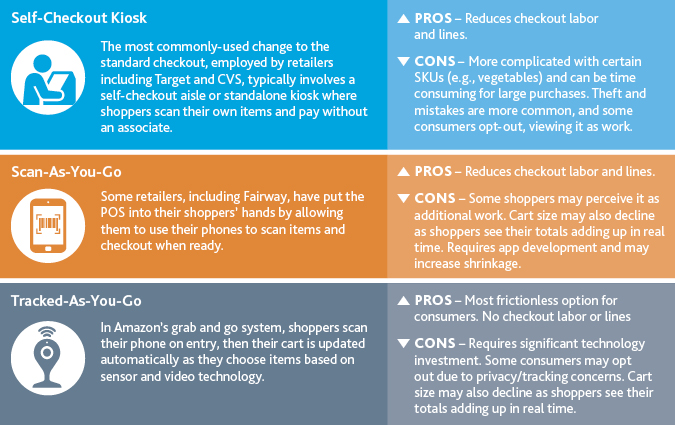Will Checkout Innovations Deliver on Their Convenience Promise?
By Natalie Kotlyar
The idea behind innovating the checkout process is simple: reduce friction to increase convenience.
The reality is much more complicated.
Convenience is subjective, and execution is everything.
What do consumers really perceive as friction? How does the checkout process impact cart size? Are cameras better than cashiers? Can it reduce costs? Will it impact shrinkage? Will there be a privacy blowback?
As retailers consider their checkout procedures ahead of peak season, it’s critical that they carefully weigh their options and ensure any checkout changes are aligned with their key customers’ desires, resources and brand identity.
Checkout Changes
Retailers’ checkout innovations roughly fit into three main categories: adding self-checkout kiosks or aisles, deploying scan-as-you-go technology through mobile devices, or enabling tracked shopping through sensors and cameras.
Each option has pros and cons and requires a level of technology and capital investment that should be factored into potential ROI.
Once retailers understand their options, they must determine which path, if any, is right for their company and customer.

Consider Your Customer
Successful retail brands know their customers well. While preferences vary by age and demographic, retailers will need to carefully consider their key shoppers, understand their checkout goals today, and forecast how preferences might change in the near future. For example, while a Phononic’s report found that 79% of consumers believe grocery stores will be primarily self-checkout by 2024, is that truly what a majority of consumers want, or are retailers just pushing them in that direction? The data is mixed, at best. A study of 526 shoppers conducted by IoT and mobile device management firm SOTI reports that 73% of respondents prefer self-checkout over engaging with store associates. However, in 2018, Walmart ended a scan-and-go pilot due to customer dissatisfaction and low adoption. And, search the web and you can find a number of articles and memes describing the scourge of error messages like “unexpected item in baggage area.” It’s clear that consumers feel strongly about checkout, and retailers should ensure their options appeal to their specific shoppers.
Consider Your Technology
The first self-checkout machines entered stores nearly two decades ago, and research firm RBR forecasts that there will be 335,000 in stores across the world by 2020. Technology advancements continue to move at a fast clip, improving the standard self-checkout experience and paving the way for new options like Amazon’s grab and go. Recent pilots also include AI that can make product recommendations or suggestions at checkout and as consumers are shopping, offering opportunities for up-selling that may not have been possible in stores before. As with most technology investments, retailers must first consider their underlying infrastructure and whether it can support their desired outcomes, then weigh the risks and reward of a potential investment. And, retailers must remember that technology, like people, is fallible. Target store registers recently went down for several hours across the country, creating multi-hour-long lines and a customer service nightmare.
Consider Your Security
Security—both in terms of consumer data protection and theft prevention—should also be built into any new or enhanced checkout system. A study of more than 2,500 consumers by Voucher Codes Pro found that a whopping 20% admitted to having stolen something at self-checkout. A 2018 article in The Atlantic further reports that self-checkout theft is so common that some store employees have developed shorthand to describe it. Common tricks include changing item stickers, selecting a cheaper produce code and passing through items without scanning. While cameras and store attendants are often in place to reduce theft or even unintentional scanning mistakes, retailers will need to carefully weigh potential loss as a part of their checkout innovation strategy.
Consider Your Service Approach
As e-commerce and mobile commerce sales skyrocket, retailers have long labored over how to get shoppers into their stores. From in-store experiences, to exclusive products, to personal service, many brands remain focused on creative or high-touch strategies to engage shoppers. If your brand is built on customer or personal service, or your shoppers rank that as a high brand value, your checkout strategy should reflect it. This might mean an approach that blends technology and people, or deploying more, not fewer, associates with mobile checkout options throughout your store. If your shoppers prioritize fast over personal service, mobile or tracking checkout options could align your service promise better.
While cutting costs and enhancing the customer experience are key drivers of in-store innovations, including changes to the checkout process, retailers must be thoughtful about the right approach for their individual customers, opportunities and brand. Even as brands invest in emerging technology, people remain critical. Despite the goals of reducing in-store labor needs, the Bureau of Labor Statistics forecasts just a 1% decline in the number of cashiers by 2026. As store employee roles evolve and become technology-enabled, retailers should be sure they are accordingly upskilling and training their associates to meet changing consumer needs and demands. In the end, it’s the right combination of personal touch and convenience that will win the day—but “right” looks different in every retail experience.
SHARE